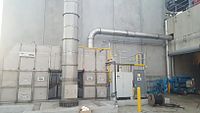
Photo from wikipedia
Abstract Waste heat recovery using a thermoelectric generator (TEG) is a promising approach for vehicle original equipment manufacturers to reduce fuel consumption and lower CO2 emissions. A TEG can convert… Click to show full abstract
Abstract Waste heat recovery using a thermoelectric generator (TEG) is a promising approach for vehicle original equipment manufacturers to reduce fuel consumption and lower CO2 emissions. A TEG can convert otherwise wasted thermal energy from engines to electricity directly for use in the vehicle systems. This paper focuses on the development of a dynamic model of TEG system designed for vehicle waste heat recovery, which is made up of counter-flow heat exchangers (HXRs) and commercial thermoelectric modules (TEMs). The model is built from thermoelectric materials into a TEM and then into a TEG system. Compared to other TEG models, the tuning and validation process of the proposed model is more complete. Experiments are done on both a TEM test rig and a heavy-duty diesel engine, which is equipped with a prototype TEG on the exhaust gas recirculation (EGR) path. Simulations of steady-state operating points as well as the response to typical engine cycle test show good agreement with experimental data. A TEG installed upstream of the after-treatment system in a heavy-duty truck has been modelled to predict the temperatures and power output in a dynamic driving cycle. The simulation results of temperatures show the model can be used as a basis to develop a control system for dynamic operation to ensure safety operation of TEG and efficient operation of the after-treatment system. A comparison of power output of the systems under different scenarios underlines the importance of integration of TEM with HXRs. Based on the simulation results, around 20% average power output increase can be expected by optimizing the thermal contact conductance and the heat transfer coefficient of hot side HXR.
Journal Title: Applied Energy
Year Published: 2018
Link to full text (if available)
Share on Social Media: Sign Up to like & get
recommendations!